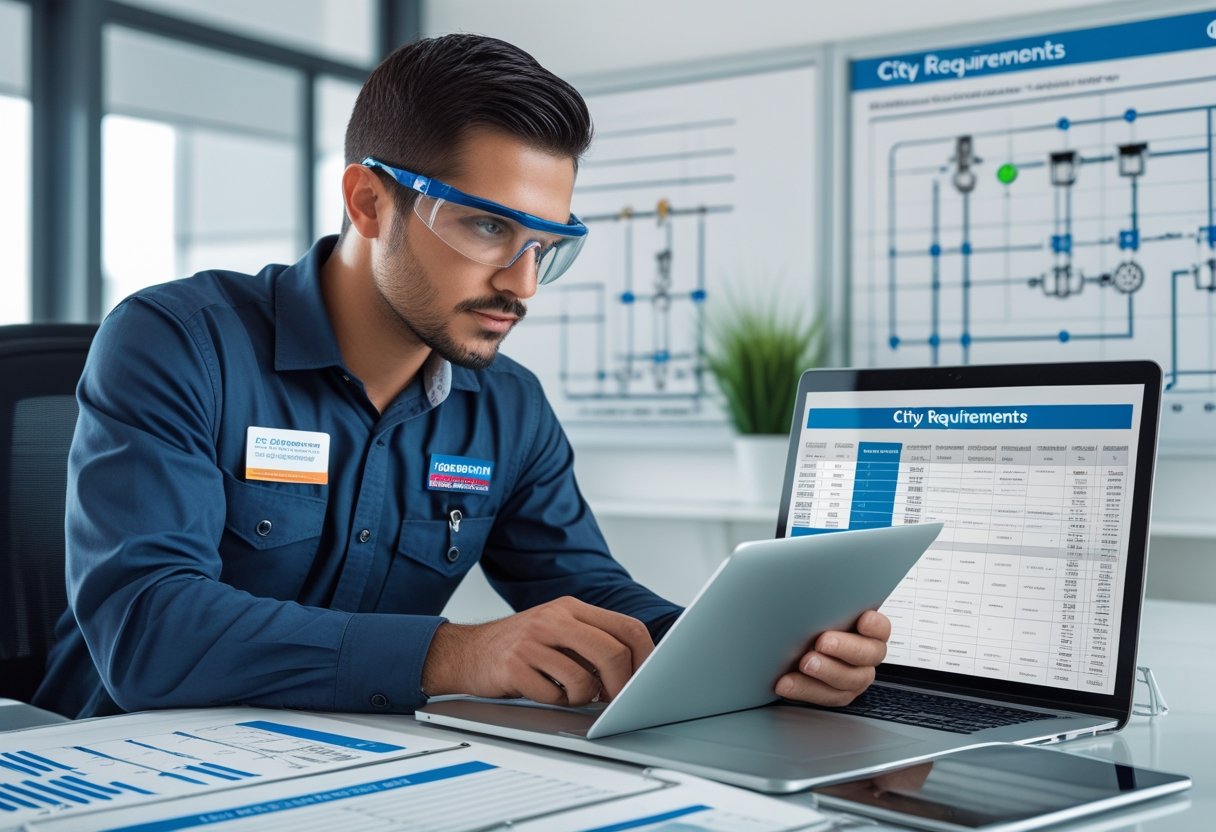Clean drinking water is essential for our health and safety, yet most of us don't think about what keeps our water supply free from contamination until something goes wrong. A backflow prevention device is a crucial safety barrier that stops contaminated water from flowing backward into our clean water supply, protecting us from serious health hazards.
When water pressure drops unexpectedly, contaminated water can get sucked back into the main water lines. This dangerous situation is called backflow, and it puts our entire potable water system at risk.
Protecting our water requires the right equipment properly installed and maintained. We'll explore the different types of backflow preventers, how they work, and why they're so important for keeping our drinking water safe.
Fundamentals of Backflow Prevention
Backflow preventers stop contaminated water from flowing backward into clean water lines, protecting public health through mechanical barriers and check valves.
Understanding Backflow
Backflow happens when water flows opposite its intended direction in a plumbing system. This creates a serious risk of contamination when non-potable water mixes with clean drinking water. A cross-connection forms when clean water pipes connect to systems containing non-potable water. Common examples include garden hoses, irrigation systems, and industrial equipment.
Contamination through backflow can introduce chemicals, bacteria, or other pollutants into our drinking water. This makes the water unsafe for consumption and daily use.
Types of Backflow: Backpressure and Back-Siphonage
Back pressure occurs when downstream pressure exceeds supply pressure, and this often happens in industrial settings where pumps or heating systems create higher pressure than the main water supply.
Back-siphonage happens when negative pressure develops in the supply line. This can pull contaminated water back into clean pipes - similar to drinking through a straw.
Here are the key differences:
- Back pressure:
- Caused by higher downstream pressure
- Common in boilers and pump systems
- Requires pressure-type prevention devices
- Back-siphonage:
- Results from supply line vacuum
- This can occur during water main breaks
- Prevention focuses on air gaps and vacuum breakers
Backflow Preventer Types and Mechanisms
Each type of backflow preventer offers specific protection levels based on the risk and application.
Air Gap and Atmospheric Vacuum Breakers
An air gap is the simplest form of backflow prevention, creating a physical separation between the water supply and any potential contaminants. The gap must be at least twice the diameter of the supply pipe.
Atmospheric vacuum breakers (AVBs) use a float check valve that closes when water flow stops. These devices work well for low-hazard applications like irrigation systems. AVBs must be installed at least 6 inches above the highest outlet, and they can't be used under constant pressure for more than 12 hours at a time.
Pressure Vacuum Breaker Assembly
PVBs add springs and check valves to provide more protection than basic vacuum breakers. They work well for outdoor irrigation and can handle constant pressure. These devices need to be installed 12 inches above the highest sprinkler head. They also include test cocks for annual testing and maintenance.
PVBs protect against back-siphonage but not backpressure, and are suitable for moderate hazard situations where water flows downward.
Double Check Valve Assembly
DCVAs use two spring-loaded check valves in series, stopping contaminated water from flowing backward through the system. These devices work best for low-to-moderate-hazard applications.
Common uses include:
- Fire sprinkler systems
- Irrigation systems
- Boiler feeds
- Food processing equipment
DCVAs can be installed below ground in a vault, but they need regular testing to ensure both check valves work properly.
Reduced Pressure Principle Assemblies
RPZ assemblies provide the highest level of protection and use two check valves, plus a pressure-differential relief valve between them. If either check valve fails, the relief valve opens and dumps water outside. This creates a visible warning of problems.
RPZs are required for high-hazard applications like:
- Chemical mixing stations
- Medical facilities
- Wastewater treatment
- Laboratory equipment
These devices must be installed above ground and need to be tested annually to verify proper operation.
Backflow Prevention in Different Settings
Backflow prevention requirements vary based on the specific risks and water usage patterns in each environment. Each setting needs appropriate devices and installation methods to protect water supplies from contamination.
Residential Applications
Most homes need basic backflow prevention to protect drinking water, and common spots that need protection include outdoor hose connections, irrigation systems, and water softeners.
A simple hose bibb vacuum breaker costs under $10 and prevents contaminated water from being siphoned back through garden hoses. We recommend these devices for all outdoor spigots.
For whole-house protection, dual check valves work well in most homes. These devices are compact and prevent contaminated water from flowing backward into the main water supply.
Commercial and Industrial Applications
Commercial buildings require more robust backflow prevention due to higher risks. Factories, laboratories, and medical facilities often use hazardous chemicals that must never enter the potable water supply.
Reduced Pressure Zone (RPZ) devices are mandatory in most commercial settings, and these sophisticated devices:
- Protect against both backpressure and back siphonage
- Include multiple check valves and relief valves
- Require annual testing and certification
- Must be installed by licensed plumbers
Irrigation Systems
In-ground sprinkler systems need specialized backflow preventers to keep soil, fertilizers, and pesticides out of drinking water. These systems can create both back-siphonage and backpressure conditions.
Pressure vacuum breakers (PVB) or atmospheric vacuum breakers (AVB) work well for most residential irrigation. However, commercial properties often need reduced pressure devices for their irrigation systems.
Fire Sprinkler Systems
Fire sprinkler systems present unique backflow challenges as these systems may contain non-potable water that sits stagnant for long periods. Double-check detector assemblies are common in fire systems as they are effective at:
- Monitoring water usage
- Detecting leaks
- Preventing contaminated water from entering the main supply
Anti-freeze systems also need extra protection, and RPZ devices are used when systems contain chemicals to prevent freezing.
Regulations, Standards, and Testing Protocols
Strict regulations govern backflow prevention to protect public water supplies from contamination. Therefore, every property owner must follow specific codes and testing requirements to maintain safe drinking water.
Plumbing Codes and Cross-Connection Control
The International Plumbing Code (IPC) sets clear standards for backflow prevention in public water systems. Cross-connection control programs are required at every service connection where contamination risks exist.
Local water authorities also enforce these regulations through regular inspections and monitoring. Because of this, only approved devices can be installed at water meters and other potential cross-connection points.
Common requirements include:
- Proper device selection based on hazard level
- Installation by licensed plumbers
- Annual testing and certification
- Maintenance records and reporting
Testing and Maintenance of Backflow Prevention Devices
Annual testing is mandatory for all backflow prevention assemblies, and only certified testers can perform these inspections and repairs. Failed devices need immediate repair or replacement, and property owners must keep detailed maintenance records for at least 3 years.
Key testing requirements:
- Visual inspection of all components
- Pressure testing of check valves
- Verification of relief valve operation
- Documentation of test results
Certification and Liability
Property owners bear legal responsibility for maintaining backflow prevention devices, and failure to comply can result in fines or service disconnection. Building owners must work with licensed professionals who understand local requirements and testing protocols.
Certified testers complete approved training programs and maintain current credentials, and most states require:
- ASSE certification
- Regular recertification
- Liability insurance coverage
- Documentation of all work performed
Get in touch to arrange testing of your backflow prevention system or to upgrade to a new device.










